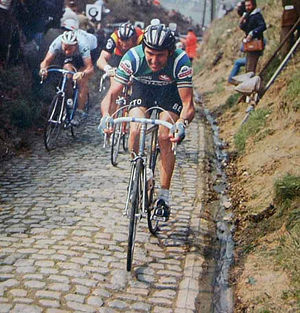Ronde van Vlaanderen
| Tour of Flanders | |
|---|---|
| Local name | Ronde van Vlaanderen |
| Region | |
| Date | Early April |
| Type | One-day race |
| History | |
| First Edition | 1913 |
| Number of Editions | 89 |
| Firstwinner | |
| Mostwins | 3 times |
| Mostrecent | |
The Ronde van Vlaanderen (English: Tour of Flanders) is a road cycling race held in Flanders, Belgium. It is held every spring, exactly one week before Paris-Roubaix, and it used to be part of the UCI Road World Cup. It is now part of the UCI ProTour and is regarded as one of the 'Monuments' of the European professional cycling calendar.
History
The race was initiated in 1913 by Karel van Wijnendaele, a former cyclist. Initially not a big success, the race was interrupted by World War I, but continued in 1919. In the 1920s and 1930s, the race became more popular, and is currently considered the most important race in Flanders, where road cycling is extremely popular. The nickname of the race is Vlaanderens mooiste, or "Flanders's finest". The town of Oudenaarde, through which the Ronde habitually passes, has a museum - the Centrum Ronde van Vlaanderen - dedicated to the race.
Course
The course contains many steep hills, often paved with cobblestones. While it is often compared to the Paris-Roubaix race in that both contain many cobbled sections, the Ronde's inclusion of many steep, and often cobbled, short hills make racing different compared to the flat Paris-Roubaix, where cobbled sections are harder and more technical.
The route does not change much from year-to-year. A major change was the inclusion of the steep Koppenberg climb in 2003, having been refurbished from its previous disrepair. The 2007 edition saw another change with the Koppenberg being dropped once more, the inclusion of the Kluisberg and the Côte de Trieu, which were unavailable through roadworks in past years and the first ascent of the Eikenmolen. Spectators try to watch the Ronde pass as many points as possible [1].
Comments

- "Only those who are in top condition can say that the Ronde is not hard. For everyone else, it's the Way of the Cross." -Andrea Tafi
Few riders have won both the Ronde van Vlaanderen and Paris-Roubaix in the same year:
- 1923 Heiri Suter

- 1932 Romain Gijssels

- 1934 Gaston Rebry

- 1954 Raymond Impanis

- 1957 Fred De Bruyne

- 1962 Rik van Looy

- 1977 Roger De Vlaeminck

- 2003 Peter van Petegem

- 2005 Tom Boonen

The day before the race sees the cyclosportive (open) race version of the Ronde in which amateur cyclists participate in large numbers.
Winners
External links
- The official Ronde van Vlaanderen website
- Cyclosportive - ride the course the day before
- The Centrum Ronde van Vlaanderen website - available in English